No matter the inspiration, religions are prone to human failure
What is Religion?
Religion is mostly prehistoric: “The bulk of the human religious experience pre-dates written history.” 30,000 years of pre-history versus 7,000 years written. Prehistoric religious beliefs are credited since 35,000 BC, when burials began to include decoration of the body and accompanying artifacts.[1]
Britannica describes religion generally as organized beliefs that guide a relationship with supernatural gods, spirits, other people, or the natural world. Religions often address the nature of life and our fate after death, and they are a source of spiritual or moral authority.[2]
English philosopher Edward Herbert (1583–1648) listed these common beliefs for post-Reformation Christian religions:
- there is a supreme deity,
- this deity should be worshipped,
- the most important part of religious practice is the cultivation of virtue,
- one should repent for wrong-doing, and
- one is rewarded or punished in this life and the next.
Herbert used Protestant monotheism as his model, but recognized that other cultures and times worshipped multiple gods, celestial bodies, or forces in nature. And later authors have extended the concept to include quasi-religions such as Humanism, Marxism, and Nationalism [3], although others consider these to be secular or even anti-religious.
World Religion Demographics 2010
Source: “The Global Religious Landscape,” Pew Research Center, December 18, 2012 [4]
World Religions by % Population 2010
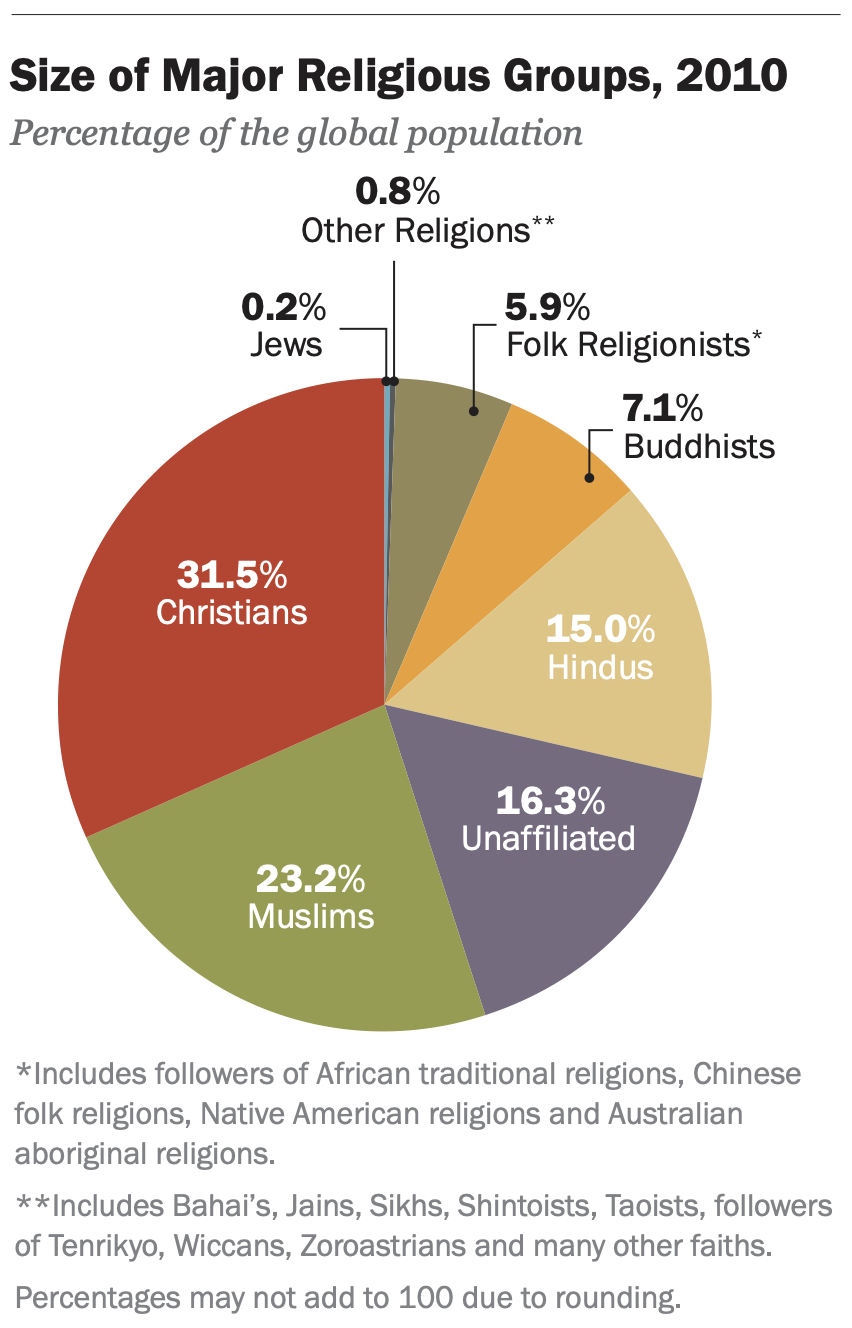
Majority Religion by Country 2010
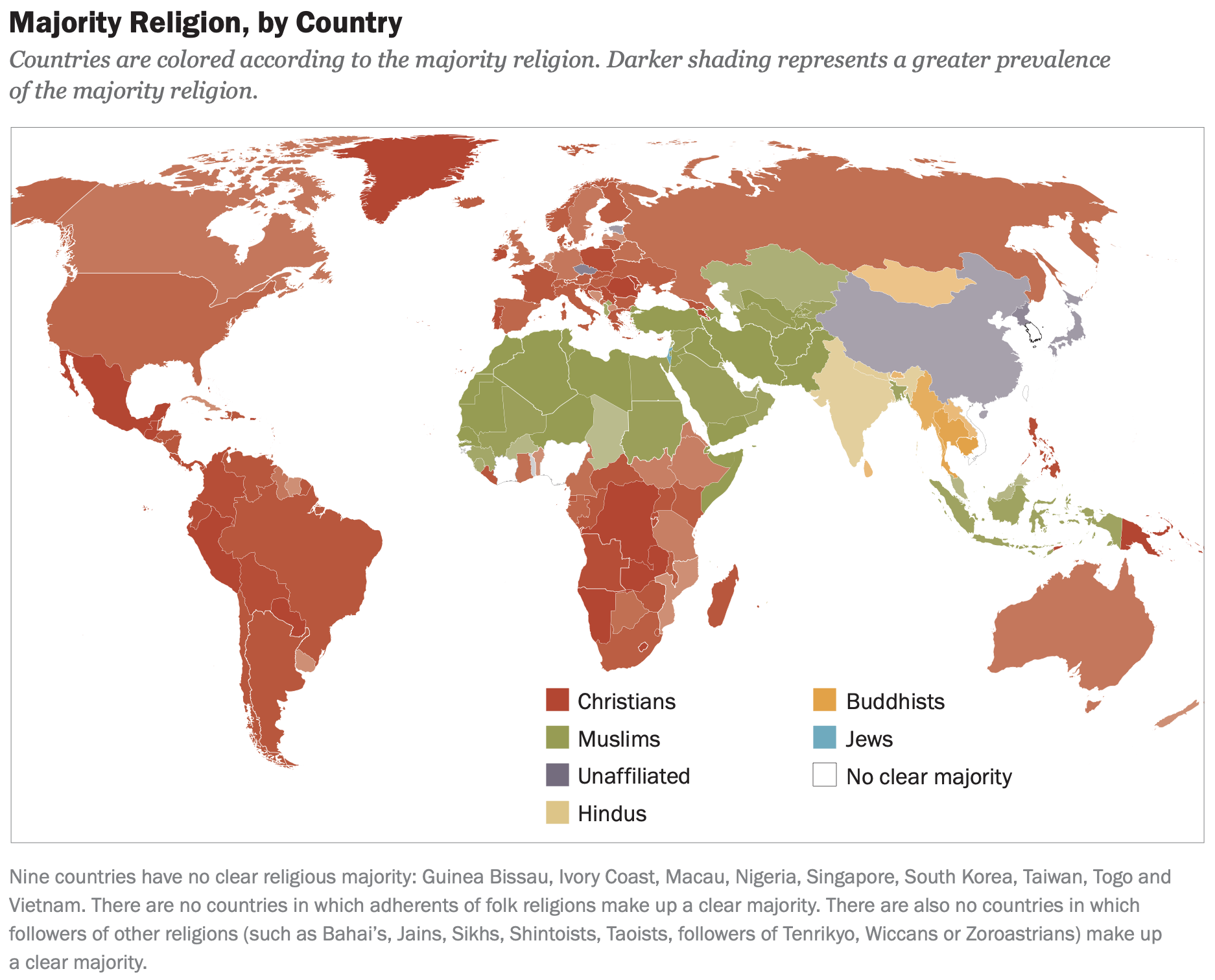
Summary of U.S. Religion Demographics 2014
Pew Research Center, May 12, 2015, “America’s Changing Religious Landscape”[5]
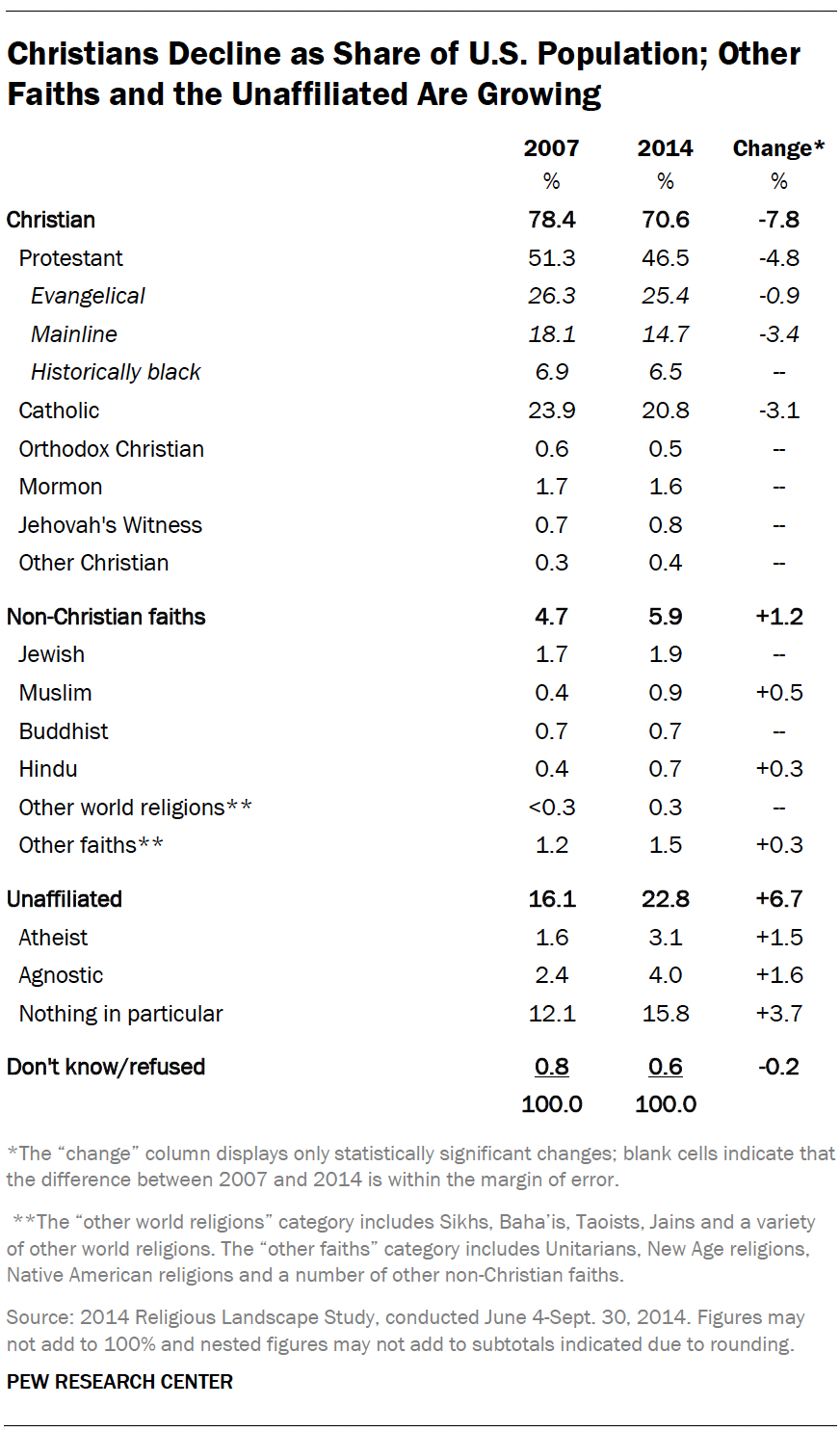
Benefits of Religion
Life and Death
One reason for the continuous interest in religion is the belief that it provides answers for our biggest questions: “What is the meaning of life?” and “What happens after I die?” 37,000 years of ritual burials show a definite interest in that.
But there may be a problem with finding the one, true answer among the many religions that all claim an exclusive truth. Pascal’s wager requires picking the right religion to win. Later philosophers have complained that it’s impossible to choose among religions with differing but exclusive rules for salvation, and no way of knowing who’s right.[6]
Morals
Religion can provide the benefit of morals, or standards that guide how we act in society with others. Historically, morality came from religious teachings [7], but as our societies have become more diverse social rules of behavior are more likely to come from laws and governments, whether secular or a theocracy that enforces a state religion.
Modern democracies are generally secular, so religious beliefs aren’t subject to sanctions and religious leaders don’t make political decisions. Proponents of religious governments argue that secular governments can’t enforce moral behavior [8], but that ignores the ability of secular nations to pass and enforce consensus laws.
Good Works
One moral taught by most religions is the virtue of charity, caring for “our neighbor as ourselves.”[9] The idea dates back to Confucius (551–479 BCE) and is prominent in Buddhism, Christianity, Hinduism, Islam, Judaism, Taoism, and “the rest of the world’s major religions”.[10]
Leaders of the world’s major faiths have endorsed charity as the “Golden Rule.” Although it’s a concept that “no religion misses entirely,” belief in God is not necessary to endorse it. The Golden Rule appears “in some form in almost every ethical tradition,” religious or secular.[11]
Healthcare
Charitable works of mercy in Christianity include care for the sick. Early orders of Christian monks began to provide this with the sick patients staying in their monasteries. This helped remove the stigma from illness and provided a basis for future public health care.[12] Even today one-third of the hospitals in Wisconsin are Catholic, and Catholic hospitals treat one in every seven patients in the United States.[13]
Costs of Religion
Bad Works
Religious Wars

The history of religion is a history of religious wars. Wars between different gods. Wars between the same God, but with different interpretations. Forced conversions of an entire empire to make religious war possible.
Some argue that it’s difficult to separate ethnic, economic, or national reasons for conflict, and one estimate for recorded war where religion was the primary cause is only 7%. But religion is a strong part of ethnic identity, and a good reason to treat the enemy as fundamentally different and “Other.” A definition of religious war more general than holy is “a war legitimized by religion or for religious ends.”
There’s no question that the spreading of Christianity by Roman armies in Europe or Islam by Arab armies in the Middle East, North Africa, and Europe was religious war. And it’s difficult to see any primary cause for the Crusades except religion. Likewise, there were Jewish holy wars as described in Deuteronomy 20 and Numbers 31, and Shinto–Buddhist wars in the 6th century.[14]
The Safavid dynasty of Persia forcibly converted their majority Sunni Islam population to Shia Islam in the 16th to 18th centuries to better oppose Sunni neighbors like the Ottoman Empire.[15] And the still Shia government of Iran used religion to justify fighting secular Iraq from 1980 to 1988.[16]
Reference diagrams that illustrate the scope of religious wars worldwide over time include these categories:
- Europe: Inter-pagan, Christian–pagan, Christian–’heretic’, Christian–Islamic, Catholic–Orthodox, Catholic–Protestant, Inter-Protestant, Anti-Jewish pogrom, Christian–secularist
- Asia: Judaic–polytheist, Inter-Eastern religious (Hinduism, Buddhism, Sikhism, Confucianism, Taoism, Shinto), Islamic–polytheist Arab, Islamic–Zoroastrian, Inter-Islamic (Sunni–Shia), Islamic–Hindu, Christian–Islamic, Christian–Eastern religious, Islamic–Judaic
- Americas: Inter–Indigenous, Christian–Indigenous, Mormon-non-Mormon, Inter-Christian, Christian fundamentalist-secular government
- Africa: Abrahamic–polytheist, Christian–Islamic, Inter-Islamic (e.g. Sunni–Shia), Inter-Christian, Islamist or Christian fundamentalist-secular [17]
Persecution
Religious persecution can be triggered by social bigotry or state regulations. The repression of sub-groups is a common theme in history, and religion plays a large role in determining an individual’s identity and beliefs. Religious differences can be significant socially. Pew Research Center data has shown that Christians, Islamics, and Jews are persecuted in more countries around the world than other religions. The persecutors are either the state or members of the dominant religion.[18]
Pew rates countries on religious persecution with two indexes:
- The Government Restrictions Index measures government laws, policies and actions that restrict religious beliefs and practices.
- The Social Hostilities Index measures acts of religious hostility by private individuals, organizations or groups in society.
Among the 25 most populous countries in 2018, India, Egypt, Indonesia, Pakistan and Russia had the highest overall levels of both government restrictions and social hostilities involving religion.[19] In general, more democratic governments without official religions rate lower.
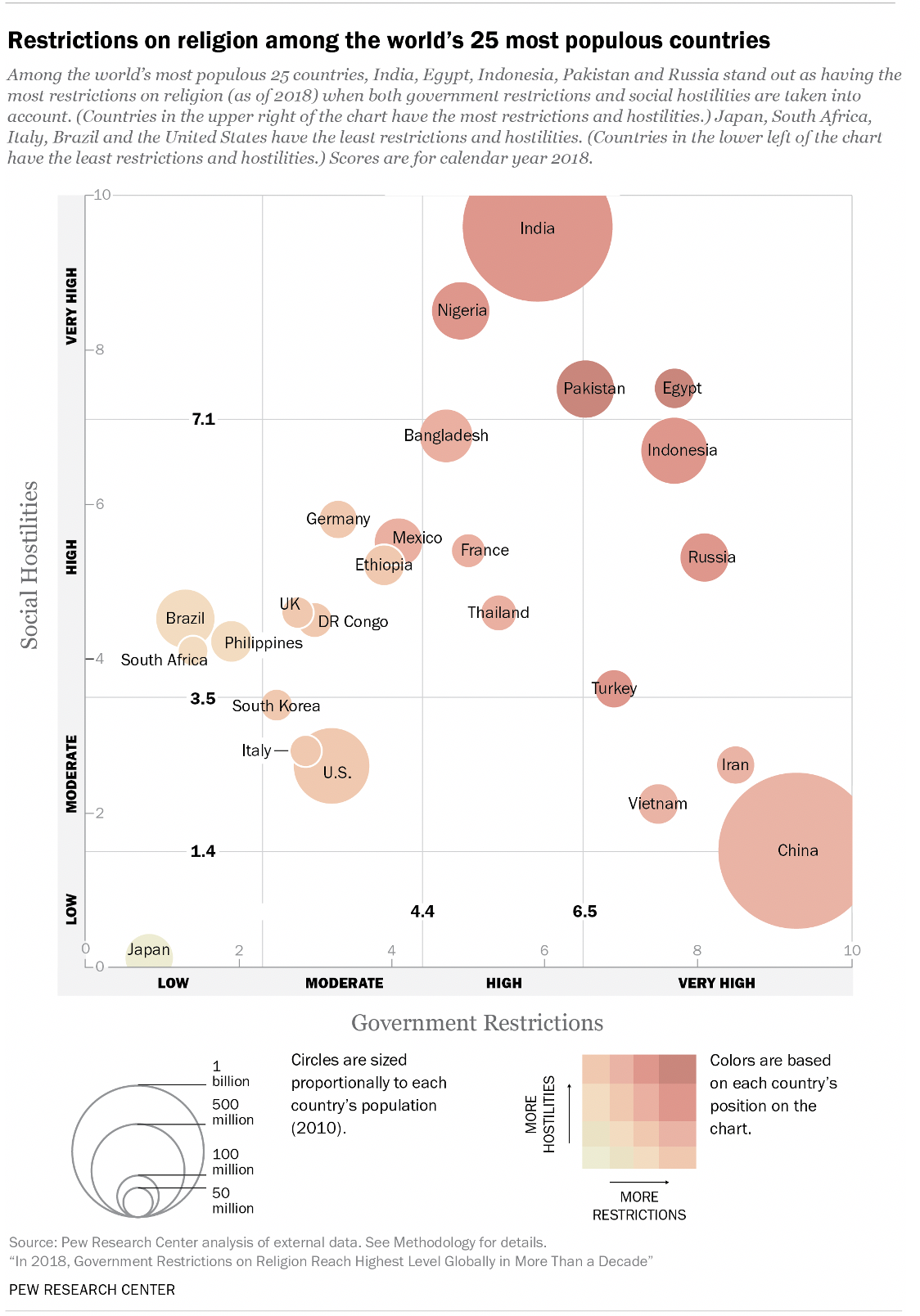
Sexual Abuse
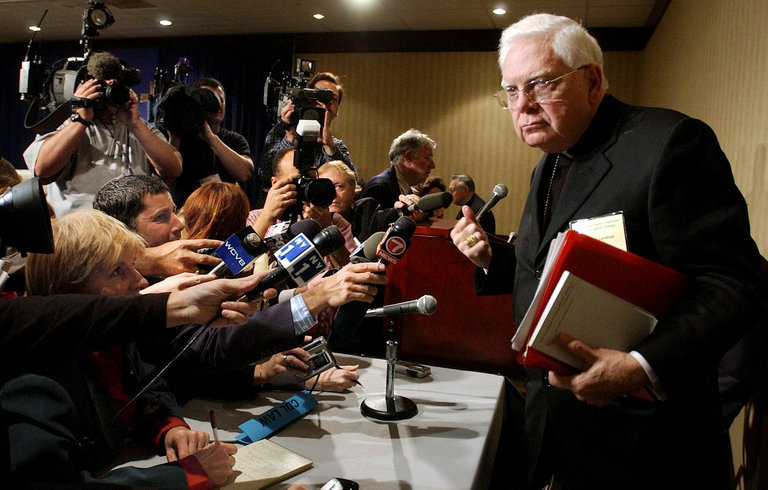
At his death, Monsignor Gino Di Ciocco in Rome defended Cardinal Law’s cover-up of sexual abuse by Catholic priests as just old fashioned. “If something happened in a family, it was the role of the father of a family to hide it.”[20]
I prefer the comments of Frank Keating, former governor of Oklahoma, prosecutor, and FBI agent. Keating compared some Catholic bishops to the “Cosa Nostra” crime family, and resigned as chairman of the Catholic Church panel on sexual abuse:
My remarks, which some bishops found offensive, were deadly accurate. I make no apology. To resist grand jury subpoenas, to suppress the names of offending clerics, to deny, to obfuscate, to explain away; that is the model of a criminal organization, not my Church.[21]
Law and other Church officials worldwide repeatedly transferred priests accused of sexual abuse without informing parishioners or law enforcement officials. He resigned as Archbishop of Boston in 2002.[22]
Healthcare
Wait, wasn’t that a benefit? Didn’t I say one-third of the hospitals in Wisconsin are Catholic, and Catholic hospitals treat one in every seven patients in the United States? [23] The fact that so much healthcare is provided by religious groups means that care can be denied for religious reasons.[24] It can literally be harmful, especially if you’re a woman or transgender.
The U.S. Conference of Catholic Bishops determines the Ethical and Religious Directives for Catholic Health Care Services. These prohibit a range of reproductive health services, including contraception, sterilization, many infertility treatments, and abortion, even when a woman’s life or health is threatened by pregnancy.
Because of these rules, many Catholic hospitals withhold emergency care from patients during miscarriages and other complications. Catholic hospitals routinely prohibit doctors from performing tubal ligations at delivery when it’s safest, and require additional surgery elsewhere after childbirth.
Catholic hospitals deny this healthcare despite billions of dollars in government payments.
Constitutional Threat
The first clause of the First Amendment says: “Congress shall make no law respecting an establishment of religion . . .”
The Founding Fathers had a lesson on established religions, those given a special status by law, from the life of Roger Williams. Williams was an English Separatist and Puritan minister who emigrated to Boston in 1631. The Pilgrims had come for freedom of religion, which meant establishing their Puritanism as the colony’s only religion. Williams upset church and civil authorities in Plymouth and Massachusetts Bay colonies by advocating Separatism and challenging the legitimacy of the colony charters, especially over Native American land transfers. The Massachusetts Bay General Court expelled Williams for “sedition and heresy.”
Williams left to establish Providence Plantations as a refuge for “liberty of conscience.” He unified other settlements to form Rhode Island colony, which became a safe haven for persecuted Baptists, Quakers, and Jews. Williams was a strong advocate of the separation of church and state and thought that government had no reason to meddle in religious beliefs. He spoke of the “oceans of blood” that had been shed trying to enforce religious conformity, and observed that well-ordered and just governments had existed without Christianity.
Williams’ writings were a key influence on the Founding Fathers.[25] Thomas Paine wrote this in 1791: “Persecution is not an original feature in any religion; but it is always the strongly marked feature of all law-religions, or religions established by law.”[26]
Conclusion
On balance the harms of religion seem to outweigh the benefits. No matter the divine inspiration, religions are human organizations prone to human failures. If your religious belief is transactional, there’s no guarantee for your purchase and no safeguards against fraud or error. You have to take it on faith. Like Groucho Marx, it’s a club I’ve resigned from.
A Timeline of Religion
Source: Wikipedia [27]
35,000–6,500 BC
Individual graves with bones stained with red ochre and containing sculpted figurines, decorations, clothing, and tools.
3200–1200 BC
Newgrange tomb and Stonehenge cremation cemetery were built. Sumerian cuneiform showing religious beliefs and records. Egyptian Pyramid tombs with religious texts. Hindu Veda scriptures. Olmec pyramids in Central America.
600–200 BC
First five books of the Jewish Tanakh or Bible, the Torah, are written: Genesis, Exodus, Leviticus, Numbers and Deuteronomy. Zoroastrianism is made the official religion of the Persian Empire. Earliest Confucian writing. The Parthenon is dedicated to the Greek goddess Athena. Oldest known version of the Tao Te Ching. Missionaries begin to spread Theravada Buddhism to southeast Asian and Mahayana Buddhism to China.
30–750 AD
Christianity is founded. Mayan step pyramids. Roman Emperor Constantine I converts to Christianity and in 313 issues the Edict of Milan expressing tolerance for all religions to legalize Christian worship. In 400 Augustine of Hippo exhorts his congregation to smash all pagan artifacts, saying “that the superstition of pagans and heathens should be annihilated is what God wants, God commands, God proclaims!” Mahayana Buddhism spreads to Japan from China. In 613 Muhammed began preaching Islam, and it spreads to North Africa, Spain, and Central Asia by 750. Sunni and Shia Islam divide c. 680. The oldest Japanese Shinto text is written in 712.
1050–1521
Christianity divides into the Roman Catholic and Eastern Orthodox churches. At least 40 Crusades or religious wars are led by the Catholic Church or European Catholics against Islamic control of Palestine. Buddhism spreads from China to Japan. The Aztec Empire polytheistic religion included human sacrifice.
1500–1784
The Spanish Empire spreads Catholicism by missions and the Inquisition. Martin Luther begins the Protestant Reformation. In 1560 the Presbyterian Church following the teachings of John Calvin and John Knox is founded in Scotland. Henry VIII creates the Church of England in 1534 when Pope Clement VII refuses to annul his marriage to Catherine of Aragon. Baron d’Holbach publishes The System of Nature, the first accepted statement of atheism in the West. The Puritans, or Pilgrims, found a colony in 1620 at Plymouth to establish Puritanism as the exclusive religion. Roger Williams is expelled from the Massachusetts Bay Colony and establishes Providence Plantations in 1636 as a refuge for “liberty of conscience”. The first Great Awakening, a Protestant religious revival in the American colonies between the 1730s to the 1770s, leads to Evangelical Christianity, an inter-denominational Protestant movement that emphasizes personal conversion (“born again“) and spreading the the Bible as God’s revelation to man. Starting in 1784 American members of the Church of England begin to create a separate Episcopal Church after the Revolution.
1790–1906
The Second Great Awakening, a Protestant religious revival in the United States, and the Restoration Movement to return to an original, “pre-denominational” Christianity, leads to the creation of the Disciples of Christ and Church of Christ. Freedom of religion in the Bill of Rights recognizes the United States as a secular government. Adventism (Seventh Day Adventists) is founded by William Miller. The Church of Jesus Christ of Latter Day Saints is founded by Joseph Smith. The Third Great Awakening, a Protestant religious revival, begins in 1857 and spreads internationally, especially in English-speaking countries. Christian Science is chartered in Boston. Zion’s Watch Tower Tract Society is formed by Charles Taze Russell as part of the Bible Student movement. Christian fundamentalism, emphasizing biblical literalism, begins. Pentecostalism begins in 1906 and later leads to the Charismatic movement.
1920–2004
Christian fundamentalism spreads among Presbyterians, Baptists, and Methodists in the 1920s. Jehovah’s Witnesses emerges from the Bible Student movement under Joseph Franklin Rutherford. The Church of Scientology is founded by L. Ron Hubbard. Wicca is publicized by Gerald Gardner. Unitarian Universalism is formed from the merger of Unitarianism and Universalism. The Church of Satan is founded by Anton LaVey. Germanic Neopaganism (aka Heathenism, Ásatrú, Odinism, and Theodism) begins a second revival. Reconstructionist Pagan movements (Celtic, Hellenic, Roman, Slavic, Baltic, Finnish, etc.) proliferate throughout Europe. The World Union of Deists is founded in the US.
Details of U.S. Religion Demographics 2014
Pew Research Center, May 12, 2015, “America’s Changing Religious Landscape”[28]
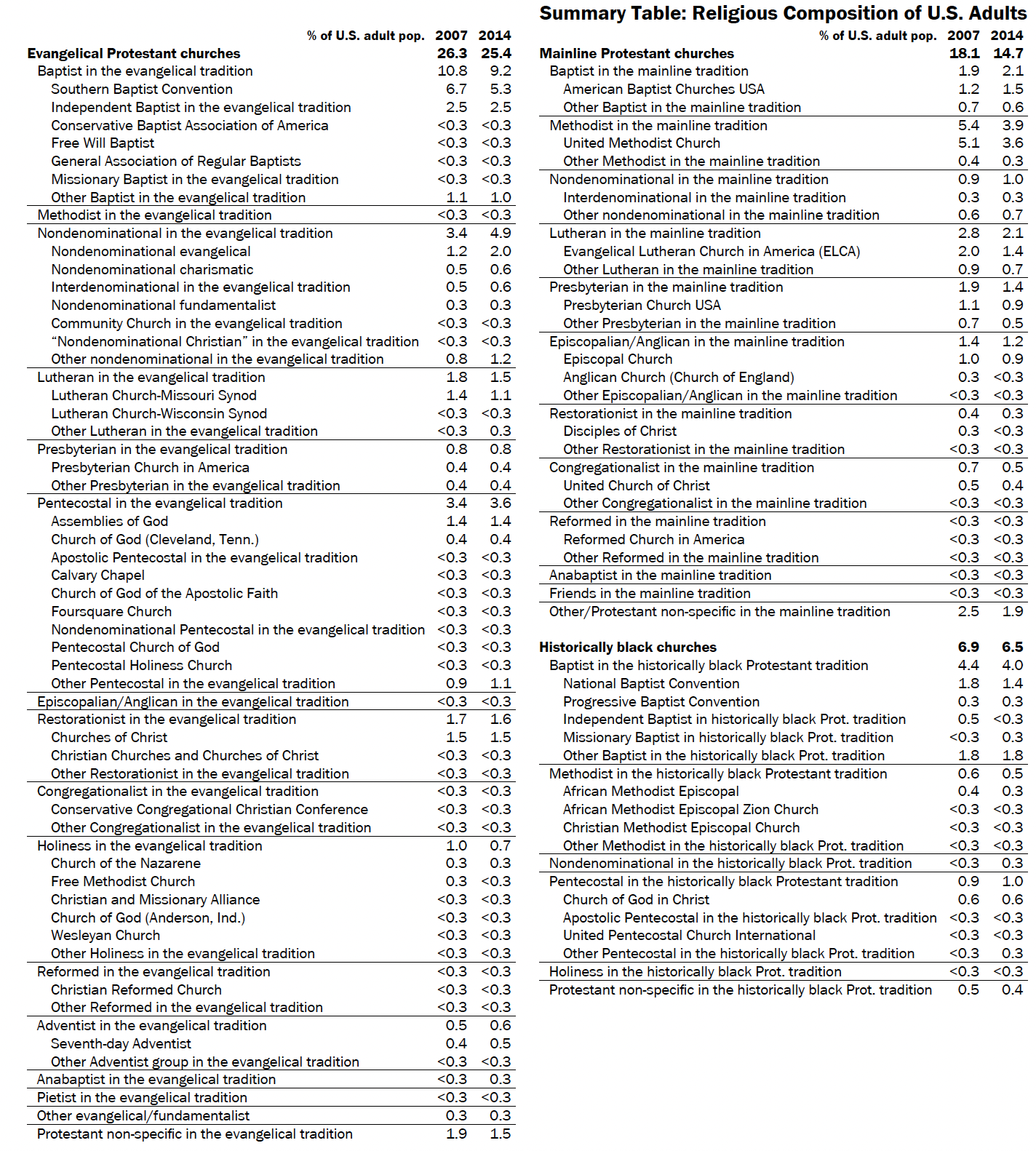
Footnotes
- “Timeline of religion,” Wikipedia, accessed 29 July 2023
- “Religion,” Encyclopedia Britannica, 29 July 2023, accessed 29 July 2023
- Schilbrack, Kevin, “The Concept of Religion,” The Stanford Encyclopedia of Philosophy (Summer 2022 Edition), Edward N. Zalta (ed.)
- “The Global Religious Landscape,” Pew Research Center, December 18, 2012
- “America’s Changing Religious Landscape,” Pew Research Center, May 12, 2015
- “Argument from inconsistent revelations,” Wikipedia, accessed 30 July 2023
- “Morals,” Ethics Unwrapped, McCombs School of Business – The University of Texas at Austin, accessed 30 July 2023
- “Secular society” in “Secularism,” Wikipedia, accessed 30 July 2023
- “Charity (Christian virtue),” Wikipedia, accessed 30 July 2023
- “Golden Rule,” Wikipedia, accessed 30 July 2023
- Ibid.
- Crislip, Andrew Todd (2005). From Monastery to Hospital: Christian Monasticism & the Transformation of Health Care in Late Antiquity. University of Michigan Press. ISBN 9780472114740.
- Parker Schorr and Rikha Sharma Rani, “Catholics run one-third of Wisconsin hospitals, putting many reproductive procedures off-limits,” Wisconsin Watch, December 18th, 2019
- “Religious war,” Wikipedia, accessed 31 July 2023
- “Safavid conversion of Iran to Shia Islam,” Wikipedia, accessed 31 July 2023
- “Religious war,” Wikipedia, accessed 31 July 2023
- Ibid.
- “Religious persecution,” Wikipedia, accessed 31 July 2023
- “In 2018, Government Restrictions on Religion Reach Highest Level Globally in More Than a Decade,” Pew Research Center, November 10, 2020
- “Cardinal Law and the U.S.-Rome Sex Abuse Divide,” Jason Horowitz, The New York Times, December 20, 2017
- “Refusing to Recant, Keating Resigns as Church Panel Chief,” Daniel J. Wakin, The New York Times, June 17, 2003
- “Law, Citing Abuse Scandal, Quits as Boston Archbishop and Asks for Forgiveness,”Pam Belluck and Frank Bruni, The New York Times, December 14, 2002
- Parker Schorr and Rikha Sharma Rani, “Catholics run one-third of Wisconsin hospitals, putting many reproductive procedures off-limits,” Wisconsin Watch, December 18th, 2019 https://wisconsinwatch.org/2019/12/catholics-run-one-third-of-wisconsin-hospitals-putting-many-reproductive-procedures-off-limits/
- “Health Care Denied,” ACLU, May 2016 https://www.aclu.org/report/report-health-care-denied?redirect=report/health-care-denied
- “Roger Williams,” Wikipedia, accessed 31 July 2023, https://en.wikipedia.org/wiki/Roger_Williams
- The Life and Works of Thomas Paine. William M. Van der Weyde, ed. Thomas Paine National Historical Association, 1925, https://press-pubs.uchicago.edu/founders/documents/amendI_religions57.html
- “Timeline of religion,” Wikipedia, accessed 29 July 2023
- “America’s Changing Religious Landscape,” Pew Research Center, May 12, 2015
Reply
You must be logged in to post a comment.